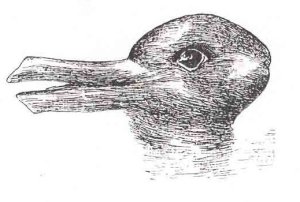There is little doubt you have not seen the optical illusion above once if not many times before. It is a very popular image that can either be seen as a duck, a rabbit or both alternatively. But could the ability to see both animals easily within the image reflect how creative you are?
Wiseman et al (2011) thought that there was a link between how the illusion is viewed and creativity levels .
He tested this by asking participants what animal they could see and, via a scale, how easy they found it to flip from one animal to the other if they could at all. The participants were then asked how many uses they could think of for an everyday object such as a chair in two minutes. They could be ordinary uses like to sit on, or more original uses such as using it to help build a fort. Wiseman assumed (note: only assumed) that the number of uses provided correlated to how creative the participant was.
Wiseman found that the participants who found it easy to flip from the duck to the rabbit and vise versa could think of an average of 5 uses for the object, whereas those who could not flip between the duck and the rabbit at all come up with less than 2 uses.
Wiseman claimed that this suggests the ease with which you can flip from rabbit to duck/duck to rabbit is a clue to how creative you are. Flipping the image is like a small flash of creative insight and when you notice the world can be seen in a different way.
However although the participants used in this study were male, female and of a good number (593 participants took part), their age and ethnicity was not recorded. This means there could be a cultural or age factor in play. Maybe the ‘more creative’ participants were the younger ones and the lesser creative the older participants. Or perhaps there is a cultural difference at play. People in Western culture are more likely to have seen the illusion before and therefore might simply be more practised at flipping from one animal to the next rather than it be based on their creativity as Wiseman has suggested.
It is also true that the data could be tainted by demand characteristics. The participant may have guessed what was being tested after being informed of both tasks and played up to it, maybe even without really meaning to. They may have also been put out that they could not easily see both animals in the illusion, and therefore believe themselves to be uncreative and as a result perform worse than they would usually on the next task. The tasks should have maybe been switched round for half of the participants to remove this possibility.
The study is only correlational. It is possible it is a factor that has not even been mentioned in the study that is effecting the relationship between the 2 tasks other than creativity.
Wiseman’s study is a very interesting one with intriguing results but further research must be done.


I agree that the experiment could have been influenced through the interpretation of the participants by guessing in what way they were meant to perform therefore biasing the results. Also your point of cultural differences is really interesting as the more accustomed a person is to optical illusions the easier they are perceived leading to generally more practice in seeing optical illusions. Therefore it can be questioned in this study whether the practice effect of optical illusions or actually creativity of the individual, as you mentioned, was measured. However creativity is not easily grasped through the measurement of an experiment as the definition of creativity may vary. Some might argue creativity contains the imput of innovative ideas , for example, others might argue creativity contains the speed in which one can improvise and implement ideas. Overall I agree with your argument that the culture plays an important role in this study and should be analysed more closely.
Whether a image can be viewed as a duck or a rabbit is too vague ad generalistic and should not be generalised as to whether or not you are creative many participants may have felt more comfortable when speaking to the researcher therefore may have been more creative whereas others may have felt shy resulting in them being less creative.Personality type therefore may have played a influenced the experiment along aide potentially cultural bias.
What is creativity ? Many may argue that to think of uses of a chair under intense circumstances may not reflect whether or not someone is creative.Hayes(1978) and Mackinnon (1962) believed for an product to be creative it must be “a)unique,novel,original and b)good,adaptive,useful,aesthetically pleasing according to the sat cards of the particular discipline .Therefore surely whether or not something is creative is subjective.